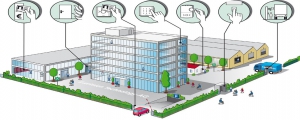System Integration
In the event of a fire alarm or an attack signal, the time required to make the right decision also depends on the natural reaction time of individuals.
Monitoring systems have been developed to minimise this time. An intuitive, well-structured user interface ensures that everything is in place when a decision must be made in a stressful situation, which allows minimising the risk to human life or property.
Visual perception is the most effective way for a human to receive information.
Visual impressions can be rapidly processed and utilised.
Graphic management systems have the great advantage of displaying actual statuses in a visual form.
The most important task of the system is to process and display a large number of data points coming from large and complex objects in a format that can easily be interpreted by the user as information and status indication.
The software works as a superior system, it receives data, for example, from systems of:
- intrusion detection;
- fire detection;
- access control;
- video surveillance;
- building automation, cooling, heating, lighting;
- signals transmitted by the escape route assurance or emergency door control systems.
Received data may be displayed in different ways:
- in graphic format with dynamic symbols;
- in spreadsheets;
- by running separate programs.
Versatile application options range from the clear display of signals to the interactive or automatic control of system components.
The system continuously monitors the state of the data points and warns the user when necessary to take the required action while it displays instructions or map details.
The user can quickly and easily interact with processes, even in multiple systems at the same time.
The interaction of subsystems:
Nowadays, numerous separate subsystems are operated in complex buildings, many of which may require synchronised operational conditions for safety, convenience and energy saving considerations. One of the important advantages of integrated systems is the ability to connect subsystems, even from different manufacturers, thereby allowing them to work together in a coordinated manner.
A few examples of the interaction between subsystems are:
- air conditioning or lighting activity depends on people moving in the area;
- the event of reading the access card should be linked to the video recorded of the person entering through respective access points;
- when fire safety or property security-related alarms occur, the event should be linked to the recorded video material;
- in case of an alarm, pre-defined lighting systems should be activated.
Flexible: The system is freely programmable, so the changes made in the monitored systems are easy to follow. The user always sees and manages the current states.
Complete solution: It includes all surveillance security systems.
Secure: Quick response, access is protected with a multi-level password.
Cost-effective: Easy setup, low maintenance requirements, integration with existing and future systems.

